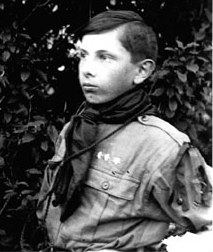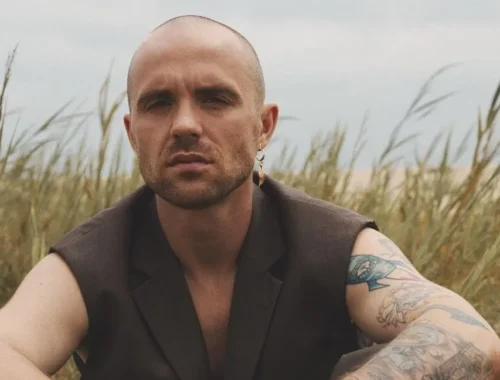
Stepan Bandera

Good afternoon, dear readers! Today we are going to talk about the biography of Stepan Bandera, a well-known political figure who headed the Organization of Ukrainian Nationalists and was one of the ideologists and leaders of the Ukrainian national liberation movement in the twentieth century. Stepan Bandera was born on January 1, 1909, in the village of Staryi Uhryniv in what was then Austria-Hungary, and died on October 15, 1959, in Munich from poisoning by a KGB agent. Among Stepan Bandera’s most famous projects are the Act of Restoration of the Ukrainian State on June 30, 1941, the creation of the Ukrainian Insurgent Army, and the organization of anti-Communist and anti-German resistance in western Ukraine during World War II. Interestingly, Stepan Bandera was posthumously awarded the title of Hero of Ukraine in 2010, but this decision was overturned by a court the same year. If you want to learn more about the life and work of this outstanding personality, we invite you to read our article.
Contents
ToggleChildhood and family
Stepan Bandera was born to a Greek Catholic priest, Andriy Bandera, and his wife, Myroslava. He was the third of nine children, of whom only six survived to adulthood. Stepan had four sisters (Maria, Oksana, Volodymyr, and Marta) and two brothers (Oleksandr and Vasyl). Since childhood, Stepan had been in poor health, suffering from rheumatic joints, which often left him unable to walk. He also suffered from scarlet fever and diphtheria. His mother died of tuberculosis when he was 14 years old. Stepan was brought up in a patriotic spirit, was obedient, respected his parents and helped them with the household chores. He also loved to read books, especially historical and adventure books. In 1922, he joined the Plast, where he practiced physical education, learned survival in nature, armed combat, and preparation for the revolutionary struggle.
Education

Stepan Bandera studied at the Stryi Gymnasium, where he excelled in mathematics, physics, chemistry, Latin, German, and Polish. He also studied English, French, and Italian on his own. At the gymnasium, he was an active member of the Ukrainian student society Sich, where he was engaged in educational, cultural, and national liberation work. He also participated in the creation of the secret organization Revolutionary Troops of Ukraine, which aimed to prepare an uprising against the Polish authorities. In 1927, he joined the Ukrainian Military Organization (UVO), and in 1929, the Organization of Ukrainian Nationalists (OUN). In 1931, he graduated from high school with honors and entered the Lviv Polytechnic Institute, Faculty of Architecture. In 1934, he was arrested by the Polish police for participating in the assassination of Polish Interior Minister Bronislaw Peracki, who was pursuing a policy of pacification of the Ukrainian population. For this, he was sentenced to death, which was later commuted to life imprisonment.
Life path
Stepan Bandera spent 10 years in Polish prisons and concentration camps, during which he did not stop his political activities. He was one of the leaders of the OUN, which split into two wings, the Melnykites and the Banderaites. He was also elected chairman of the OUN-B leadership, which recognized him as the head of the Ukrainian state. In 1939, he was released from prison as a result of the attack on Poland by Nazi Germany and the Soviet Union. He moved to Krakow, where he became the chairman of the Ukrainian National Committee, which aimed to establish contacts with the German occupiers and achieve recognition of Ukrainian statehood. However, the Germans did not agree to this and demanded that Ukrainian nationalists submit to their authority. On June 30, 1941, the day German troops entered Lviv, Stepan Bandera, together with Yaroslav Stetsko, proclaimed the Act of Restoration of the Ukrainian State, in which he declared Ukraine’s independence from all foreign invaders. He also declared himself the Head of the Ukrainian State and Stetsko the Prime Minister. This move angered the German leadership, which believed that Ukrainians should be a subordinate people. On July 5, 1941, Stepan Bandera was arrested by the Gestapo and sent to Berlin, where he was sentenced to prison.
From early 1942 to August 1944, Bandera was held in the Sachsenhausen concentration camp in the Zellenbau bunker in relatively good conditions. He continued to lead the OUN-B through a secret mail service provided by his wife, Jaroslawa, and other collaborators. He also wrote political memoranda outlining his vision of the future Ukrainian state, which was to be democratic, social, legal, national, and European. He called for the creation of a Ukrainian army that would fight against both totalitarian regimes, Nazi and communist. He also called for cooperation with other nations that sought freedom and independence, including Polish, Belarusian, Lithuanian, Czech, Slovak, Yugoslav, and others.
In August 1944, Bandera was transferred from Sachsenhausen to the Flossenbürg concentration camp, where his conditions worsened. He was subjected to torture, starvation, cold, and isolation. He also became the subject of medical experiments conducted by German doctors. He withstood all these trials with dignity and did not betray his ideals. He refused the Germans’ offers to cooperate with them or to recognize their authority over Ukraine. He also refused offers from Soviet agents to go over to their side or to negotiate with them. He remained loyal to his people and his goal of an independent Ukraine.

In April 1945, Bandera was released from Flossenburg by American troops, who recognized him as a political prisoner. He moved to Munich, where he resumed his activities as head of the OUN-B. He also became one of the initiators of the creation of the Ukrainian Main Liberation Council (UHVR), which was to represent the interests of the Ukrainian people in the international arena. He called for the continuation of the struggle against the Soviet regime that occupied Ukraine and for support for the Ukrainian Insurgent Army (UPA), which waged a guerrilla war in western Ukraine. He also called for cooperation with other anti-Communist forces, including the People’s Anti-Communist Union (NASO), which united representatives of different nations living under Soviet oppression.
On October 15, 1959, Stepan Bandera was assassinated in Munich by KGB agent Bohdan Stashynskyi, who poisoned him with cyanide gas. His death caused a wide response in the world community, especially among the Ukrainian diaspora. Many people expressed their grief, respect and solidarity with the Ukrainian people who lost their leader and symbol. In Munich, London, Paris, New York, Toronto and other cities, mass funerals and memorial events were held, attended by representatives of different nationalities, confessions, political parties and public organizations. Ukrainian churches declared a day of mourning and held memorial services for the repose of Stepan Bandera’s soul. Ukrainian newspapers, magazines, radio and television devoted special issues to him, covering his life, activities, ideas and services to the Ukrainian cause. Ukrainian writers, poets, painters, composers, actors and other creative people have expressed their respect and gratitude to Stepan Bandera for his inspiration, example and dedication. Ukrainian schools, universities, libraries, museums, parks, streets, squares, and monuments have been named in his honor or decorated with his portraits and quotes. Ukrainian athletes, musicians, singers, dancers, and other performers have dedicated their victories, concerts, songs, dances, and other performances to him. Ukrainian soldiers, insurgents, patriots, and activists continued his work, fighting for Ukraine’s freedom, independence, and sovereignty.
Conclusion.
In this article, we have described the biography of Stepan Bandera, a well-known political figure who was one of the leaders of the Ukrainian national liberation movement in the twentieth century. We looked at his childhood, family, education, career, and achievements. We showed how he sacrificed his life for the idea of an independent Ukrainian state, which he proclaimed together with his associates on June 30, 1941. We also described his death at the hands of a KGB agent who poisoned him with cyanide gas on October 15, 1959. We noted that his death caused a wide resonance in the world community, especially among the Ukrainian diaspora, which honored his memory, respected his legacy, followed his example, and carried out his will.
We believe that Stepan Bandera was an outstanding, talented, courageous and influential personality who made a significant contribution to the development of Ukraine. He was a true patriot who was not afraid of any enemy, did not betray any comrade, and did not despise any nation. He was a true hero who did not seek glory, did not seek power, and did not enjoy privileges. He was a true leader who did not order but inspired, who did not command but served, who did not dictate but suggested. He was a true nationalist who had no hatred but love, no limitations but ideals, no enemies but friends.
We hope that our article was useful to you and that you learned a lot about Stepan Bandera. We also hope that you will find the strength, courage and will to follow his example and fight for your rights, freedoms and dreams. We end our article with a positive and encouraging tone, citing several quotes from Stepan Bandera that reflect his outlook on life:
- “You should live in such a way that you are not ashamed of your life.”
- “No one will give you freedom unless you demand it.”
- “Nothing is impossible for those who believe, who have the will and who act.”
- “Glory to Ukraine! Glory to the heroes!”.

Jeffrey Dahmer




